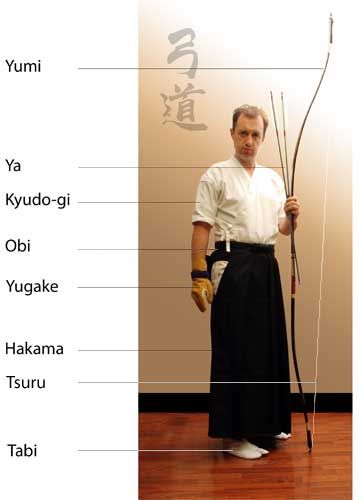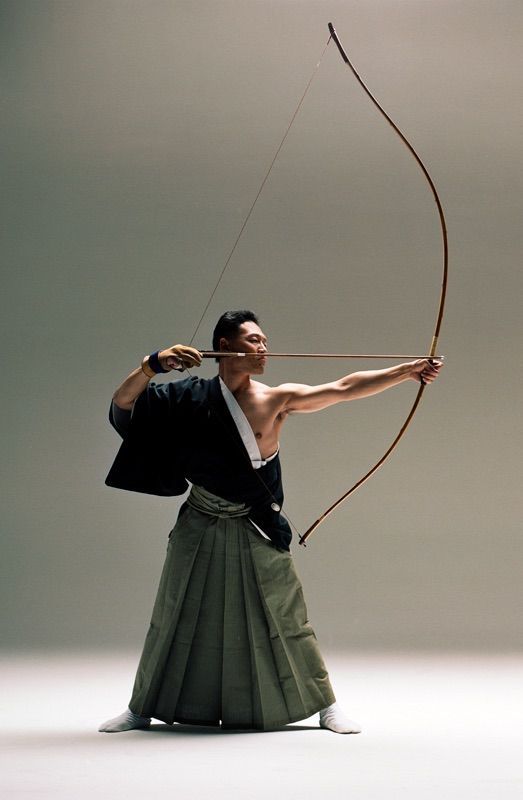Japanese Archery (Kyudo)
Japanese Archery – Kyūdō
The practice of traditional Japanese archery is known as Kyudo, which is based on kyujutsu. Archery has been practiced in Japan since pre-historical times and the first pictorial representations of the asymmetrical bow used by the ancient Japanese (known as the Yumi) are from the Yayoi period which is dated to roughly 450 BC- 300 AD.
Kyūdō means literally “the way of the bow” and its practice encompasses all aspects of archery. The roots of Kyudo lie in the Shinto tradition. Shinto is considered the indigenous religion of Japan and has the largest number of followers out of all religions in that country.
The practice of Kyudo has been highly ritualized and for the archery obsessed, can be quite therapeutic to practice or even just watch. The archer’s movements are graceful and deliberate, and everything is controlled and smooth. As well as the graces of the technique, the unmistakably unique size and shape of the Japanese bow are sure to fascinate. This article explores traditional Japanese archery – kyudo.
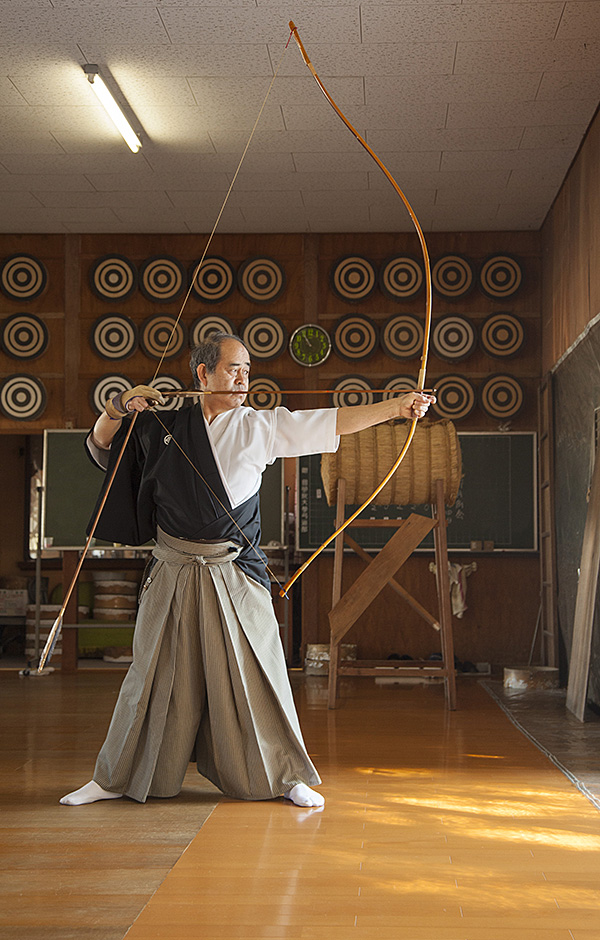
History of Kyudo
Kyudo, aka Japanese archery, is ancient. The origins of the practice stretch back to the very beginning of Japanese history. As far as we know, the first inhabitants of the Japanese islands were a relatively diverse group of hunter-gatherers known as the Jomon people. The Jōmon period is vast, and ranges over 12,000 years, from roughly 14,000–300 BCE.
Being hunters, the Jomon relied heavily on the use of the bow and arrow as a means of survival. These early bows used by the Jomon were relatively short, simple, and symmetrical self bows, much like the bows used by other indigenous peoples the world over.
According to Japanese legend, around the year 660 B.C. the first Emperor of Japan, Emperor Jimmu ascended to the throne. Already at this point in time, the bow came to be associated with political power. All later pictures of the emperor depict him holding a bow.
It was after the Jōmon period, in the so-called Yayoi period (300 B.C. – 300 A.D.) that we first begin to see the emergence of long, asymmetric bows. Contemporary Chinese written sources describe the long, asymmetrical structure of Japanese bows during this time.
Japan was strongly influenced by Chinese culture during this time. Borrowing from Chinese composite bow designs, a two-piece wood and bamboo composite was developed. Archery also became more popular in warfare and was readily adopted by a newly emerging social class, the samurai.
Kyudo in Feudal Japan
When one thinks of the samurai they usually think of feudal Japan. That was the golden age of the samurai, and of kyudo. It was after the year 1192 when Minamoto no Yoritomo became shogun, that concerted efforts were made to establish a more formal training for archery. It was during this period that kyujutsu ryu, the schools of archery technique began to flourish. The feudal period also saw the incremental development and perfection of the yumi design and manufacture. In fact, by the 16th century, bow design had reached its zenith. An authentic modern yumi is basically identical to these late 16th-century designs.
Yabusame
During the rise of the military class (samurai) in medieval Japan, there was a strong demand for skills in archery. In fact, although the samurai are most famous for their skill and use of the blade (Katana, Wakizashi), the early samurai were, in fact, horse archers. The practice of mounted archery is known as yabusame in Japanese. It is still taught and practiced in Japan today.
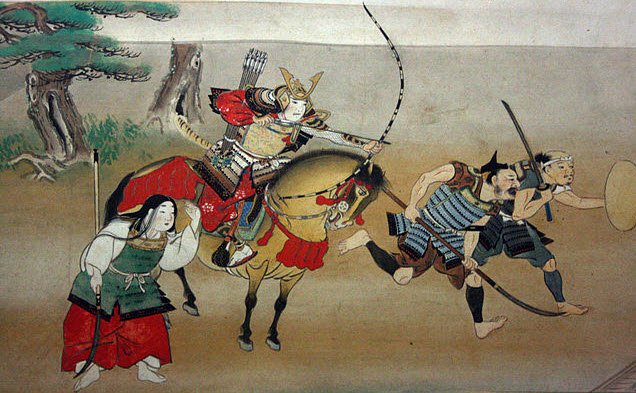
The Demise of the Samurai
The use of the bow (Yumi) was widespread until the Portuguese arrived in 1543 bringing with them matchlock rifles. Although the Japanese would soon begin the manufacture of their own matchlock rifles (tanegashima) the accuracy and rate of fire of the bow would not be surpassed for some time. The Japanese matchlock required much less skill and/or training to operate and master than did the Yumi. But a concentrated barrage of lead would prove to be the downfall of the bow-wielding samurai.

Yumi
The Japanese bow was first constructed from a single piece of wood, and through the centuries the bow evolved and was considered perfected by the 16th to 17th centuries. Modern yumi bow designs are practically identical to the late 16th-century models. Bamboo and leather were layered onto the core in several pieces resulting in a composite design. Over time, more pieces of bamboo were layered onto the core, fully encasing it.
The exact reason is unknown why the yumi has an asymmetrical design. Having the lower limb shorter than the upper limb could have helped maneuver the bow on horseback, and shoot it from a kneeling position. These are questionable hypotheses due to the fact that the asymmetric yumi design predates their use on horseback.
Another interesting aspect of the yumi from a design perspective is the idea of vibrations. Any archer who has shot a relatively long and/or heavy bow is familiar with the idea of hand-shock. This is simply the bow vibrating while dissipating some energy after an arrow is released. Interestingly, there are null points along the length of any vibrating bow. These are points along the length of the bow which experience little to no vibration. They are called nodes. The location of the nodes depends on several factors such as materials, length, and shape of the bow. For a yumi, the nodes are located roughly a third (1/3) and two-thirds (2/3) up the length of the bow. By placing the grip at the 1/3rd position, any vibrations are dampened.
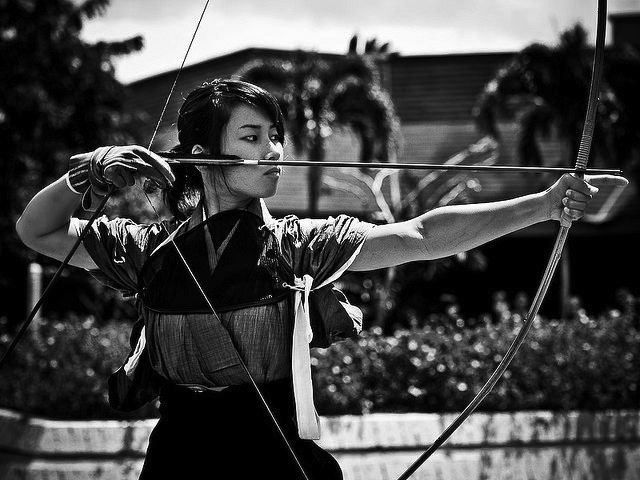
Kyudo Technique
As mentioned, the technique involved in kyudo is quite serene and graceful to behold when performed by an adept. The process may be broken down into 7 or 8 steps. They are broken down for illustrative and/or educational purposes, in actuality they a performed as one seamless motion.
The process of shooting the bow in kyudo is known as Hassetsu. The steps may be observed as follows.
【1】Ashibumi – Footing
When performing Ashibuni the archer arranges his or her footing. The torso is perpendicular to the target with the center of mass between each foot. The feet are at an angle of 60 degrees from each other and the distance between the large toe of each foot is one’s draw length (Yazuka).
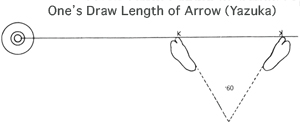
【2】Dozukuri – Forming the Torso
In Dozukuri the body and mind are centered and focused. Emphasis is placed on calming the mind and regulating the breath.
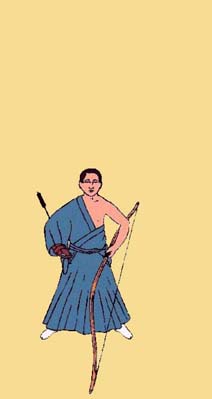
【3】Yugamae – Readying the Bow
This step involves moving the bow into position, ready to be drawn. The archer also gazes upon the target.

【4】Uchiokoshi – Raising the Bow
In Uchiokoshi the bow is raised straight up with the arrow parallel to the ground. The archer maintains proper posture and breathing as well as remaining locked on target.
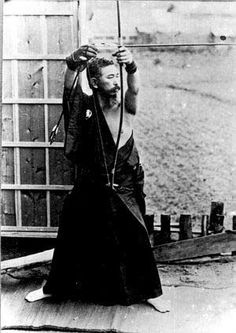
【5】Hikiwake – Drawing Apart
The Hikiwake stage is the draw. The bow is pushed forward while the string is simultaneously drawn back.
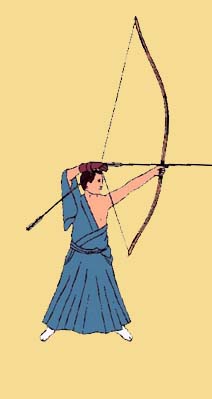
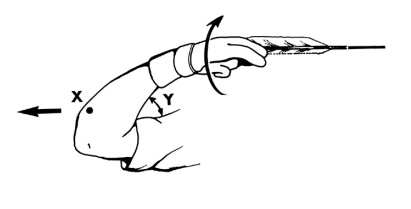
【6】Kai-The Full Draw
Kai is when the archer reaches full draw. Kai may be held for several seconds as the archer concentrates on their body and the target. Between 6 to 8 seconds is recommended in some schools.

【7】Hanare – Release
The release, physical and spiritual, of the tension built up in the draw and kai (holding at full draw).
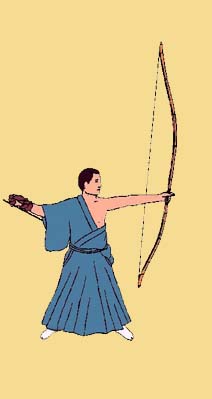
【8】Zanshin – Remaining Form(Spirit)
Zanshin may be translated as remaining body, form, or spirit. It is the physical, mental and spiritual follow through.

Japanese Archery Accessories – Kyūdō Uniform
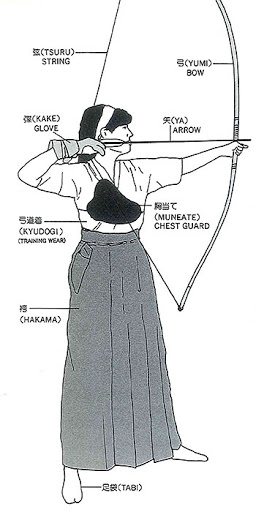
- Gi, Kyudogi , keiko-gi (top)
- Hakama (pantskirt)
- Obi (belt)
- Tabi (socks)
- Kimono
- Muneate (chest protector)
- Setta and zori (sandals)
